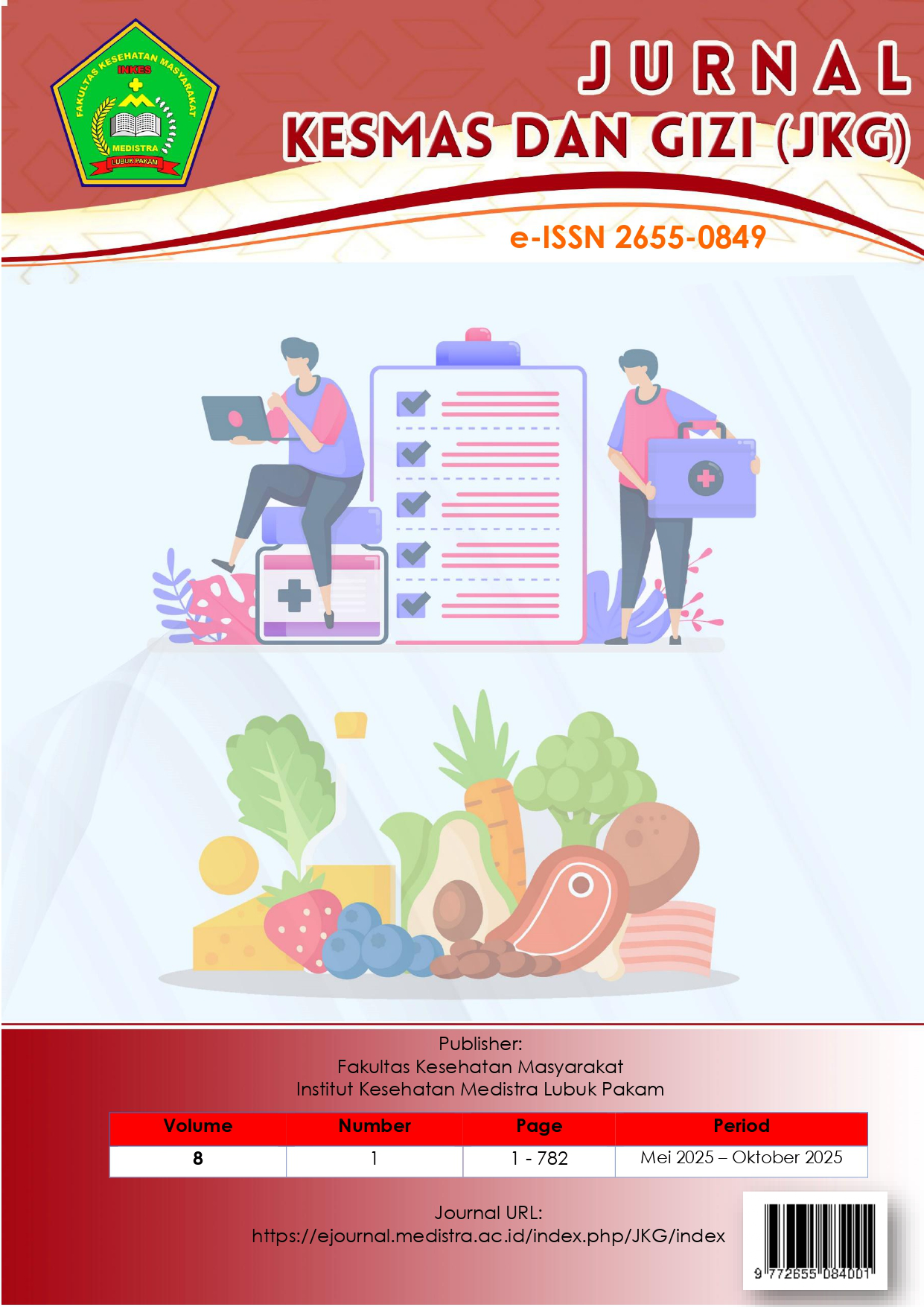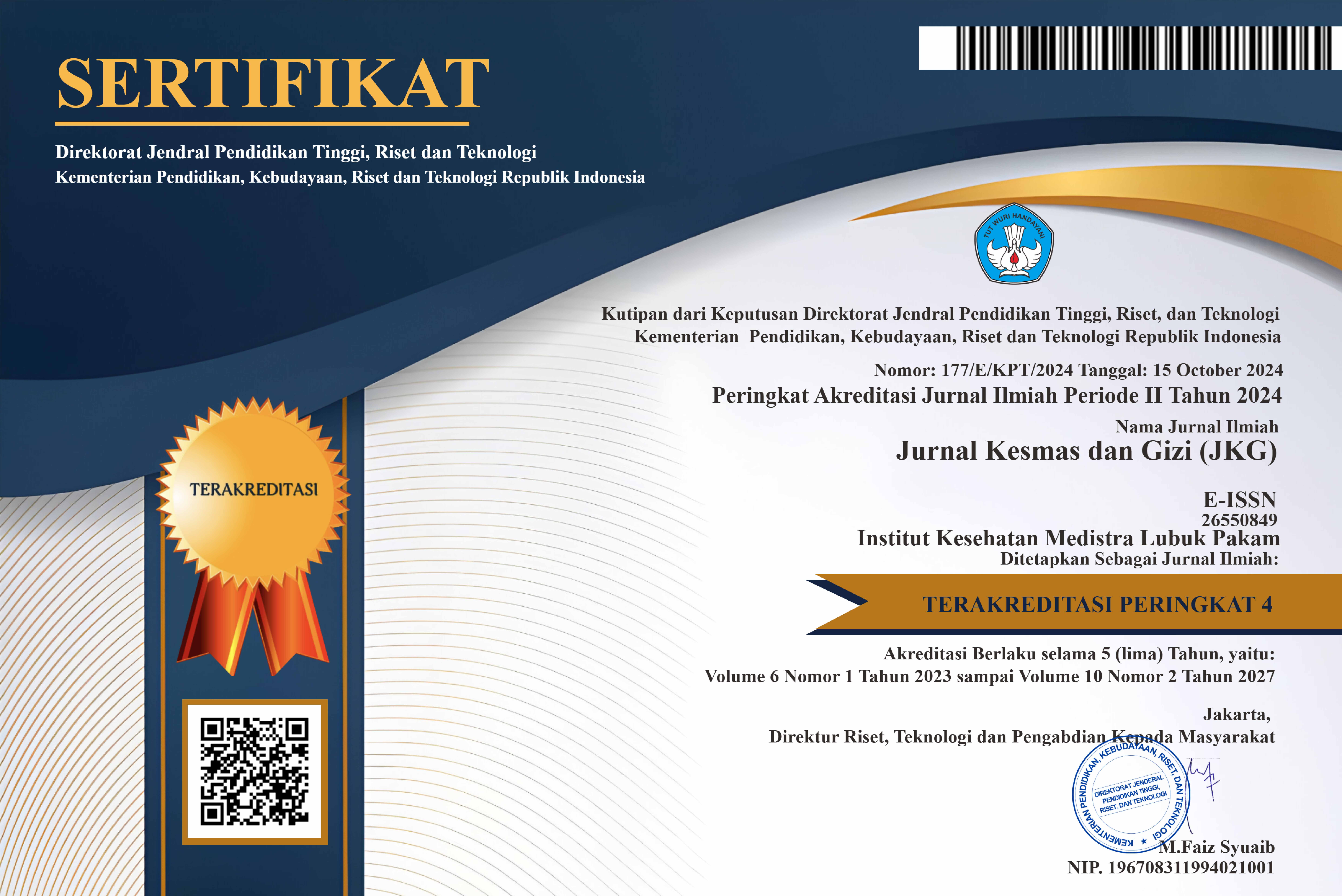The Relationship Between Local Food Intake and Body Mass Index (BMI) In Women Of Childbearing Age (WCA)
DOI:
https://doi.org/10.35451/790yts16Keywords:
Asupan, Pangan Lokal, IMT, Wanita Usia SuburAbstract
Background: Women of reproductive age (WUS) are a group of women aged between 15 and 49 years. They are considered a vulnerable group. Women with poor or severe nutritional status can develop chronic energy deficiency syndrome (CED). The direct causes of CED are dietary patterns and infections. Indonesia, which has a diverse range of food sources, can be utilized effectively. Local food is a source of food available in a region. If utilized effectively, it will provide several benefits, including affordability and ease of access. Objective: This study aims to determine the relationship between local food intake and BMI in women of reproductive age (WUS). Method: This study design is analytic cross-sectional with a sample of 162 respondents. The inclusion criteria for this study were women aged 19-39 years, women who are not pregnant, women who are not on a specific diet, and those who are willing to be respondents. The exclusion criteria were women who withdrew before the study was completed. The analysis was conducted using the Spearman rank correlation test. Results: The results show that most respondents are aged 30-39 years (79%), the majority of respondents have a secondary education level (SMA) (52.5%), respondents are in the unemployed category (84.6%), and the highest income of respondents is in the <UMR category (69.8%), normal BMI 46.9%, obesity category BMI 32.7%, overweight category BMI 13.6% and wasting category 6.8%. Conclusion: In conclusion, there is a relationship between energy and carbohydrate intake with WUS BMI. Protein and fat intake with WUS BMI has no relationship. Suggestion: It is recommended that the measurement of nutritional status in WUS can be supplemented using LILA, so that the results are more accurate. Measurement of nutrient intake can use a more detailed method, such as Food Recall.in the wasting category was 6.8%. Conclusion: There is a relationship between energy and carbohydrate intake and BMI in WUS. There is no relationship between protein and fat intake and BMI in WUS.
Downloads
References
[1] Inayatullah, K. R., Djokosujono, K., & Ramadhan, R. P. (2022). Karakteristik Kabupaten dan Kota di Indonesia dengan Masalah Gizi Ganda pada Penduduk Dewasa Tahun 2018. Media Publikasi Promosi Kesehatan Indonesia (MPPKI), 5(5), 519-529.
[2] Dieny, F. F., Jauharany, F. F., Fitranti, D. Y., Tsani, A. F. A., Rahadiyanti, A., Kurniawati, D. M. A., & Wijayanti, H. S. (2019). Kualitas diet, kurang energi kronis (KEK), dan anemia pada pengantin wanita di Kabupaten Semarang. Jurnal Gizi Indonesia (The Indonesian Journal of Nutrition), 8(1), 1-10.
[3] Umar, F. (2022). Faktor-Faktor Yang Mempengaruhi Kejadian Kurang Energi Kronik Pada Wanita Usia Subur Di Kecamatan Maiwa Kabupaten Enrekang. Jurnal Ilmiah Manusia Dan Kesehatan, 5(1), 475-486.
[4] Muharramah, A., Wati, D. A., Pratiwi, A. R., Khairani, M. D., & Saputri, A. A. Q. (2023). PENGUKURAN STATUS GIZI DAN KONSELING GIZI SEBAGAI PENGABDIAN MASYARAKAT DALAM RANGKA KEGIATAN MILAD UNIVERSITAS AISYAH PRINGSEWU TAHUN 2023. Jurnal Pengabdian Kepada Masyarakat Ungu (ABDI KE UNGU), 5(2), 125-130
[5] Nainggolan, O., Hapsari, D., Titaley, C. R., Indrawati, L., Dharmayanti, I., & Kristanto, A. Y. (2022). The relationship of body mass index and mid-upper arm circumference with anemia in non-pregnant women aged 19–49 years in Indonesia: Analysis of 2018 Basic Health Research data. PloS one, 17(3), e0264685.
[6] Baho, G. P., Indriyati, I., Kaha, H. L., Nyong, F., Peten, Y. P., Lawalu, S. P., & Silae, A. (2024). Pentingnya Peningkatan Gizi Anak Berbasis Pangan Lokal. Jurnal Nusantara Berbakti, 2(3), 58-63.
[7] Lestari, R. A., & Kurniasari, R. K. (2024). Literature Review: Pengaruh PMT Pangan Lokal Pada Balita sebagai Upaya Pencegahan Stunting. SEHATI: Jurnal Kesehatan, 4(2), 85-90.
[8] Lolan, Y., & Fauzia, D. A. (2023). Pengaruh Pangan Lokal Dan Pola Asuh Makan Terhadap Kejadian Stunting Pada Balita 6-24 Bulan Di Kota Bandung. Jurnal Kesehatan Mahardika, 10(2), 72-79.
[9] Hadju, V. A., Aulia, U., & Mahdang, P. A. (2023). Pengaruh pemberian makanan tambahan (PMT) lokal terhadap perubahan status gizi balita. Gema Wiralodra, 14(1), 105-111.
[10] Yulianasari, P., Nugraheni, S. A., & Kartini, A. (2019). Pengaruh pendidikan gizi dengan media booklet terhadap perubahan perilaku remaja terkait pencegahan Kekurangan Energi Kronis (Studi pada Remaja Putri SMA Kelas XI di SMA Negeri 14 dan SMA Negeri 15 Kota Semarang). Jurnal Kesehatan Masyarakat, 7(4), 420-428.
[11] Maharani, N. A., & Indriasari, R. (2018). Yustini,“Gambaran Asupan Gizi dan Anemia Remaja Putri KEK di SMA Al-Bahrah Jeneponto,”. Jurnal Ilmu Gizi UNHAS, 1(1).
[12] Mahmudah, A., Masrikhiyah, R., & Rahmawati, Y. D. (2022). Hubungan pengetahuan gizi, aktivitas fisik, dan asupan makanan dengan kejadian KEK pada calon pengantin di wilayah kerja Kua Tarub. Jurnal Ilmiah Gizi Kesehatan (JIGK), 4(01), 27-35.
[13] Fitriyah, N., & Setyaningtyas, S. W. (2021). Hubungan asupan energi, makronutrien, zink dan fe dengan underweight pada ibu dan balita di Desa Suwari Bawean, Gresik. Media Gizi Kesmas, 10(1), 56.
[14] Putri, M. P., Dary, D., & Mangalik, G. (2022). Asupan protein, ZAT besi dan status gizi pada remaja PUTRI. Journal of Nutrition College, 11(1), 6-17.
[15] Kristiana, T., Hermawan, D., Febriani, U., & Farich, A. (2020). Hubungan antara pola tidur dan kebiasaan makan junk food dengan kejadian obesitas pada mahasiswa Universitas Malahayati tahun 2019. Human Care Journal, 5(3), 750-761.
[16] Tade, B. Y. U., Nur, M. L., & Talahatu, A. H. (2025). Hubungan Asupan Zat Gizi Makro, Pengetahuan Gizi, dan Aktivitas Fisik dengan IMT Mahasiswa FKM UNDANA. SEHATMAS: Jurnal Ilmiah Kesehatan Masyarakat, 4(1), 114-127.
[17] Cahyani, T. D., Puspitasari, D. I., & Sarbini, D. (2024). Hubungan Asupan Zat Gizi Makro dan Frekuensi Makan dengan Status Gizi pada Mahasiswa Fakultas Ilmu Kesehatan Universitas Muhammadiyah Surakarta. Ghidza: Jurnal Gizi dan Kesehatan, 8(2), 250-257.
[18] Rorimpandei, C. C., Kapantow, N. H., & Malonda, N. S. (2020). Hubungan antara asupan zat gizi makro dengan status gizi pada remaja putri di Desa Kayuuwi dan Kayuuwi Satu Kecamatan Kawangkoan Barat. KESMAS: Jurnal Kesehatan Masyarakat Universitas Sam Ratulangi, 9(4).
[19] Khoerunisa, D., & Istianah, I. (2021). Hubungan asupan zat gizi makro dan aktivitas fisik dengan status gizi pada remaja: the relationship of macro nutritional intake and physical activity with nutritional status in adolescents. Jurnal Pangan Kesehatan Dan Gizi Universitas Binawan, 2(1), 51-61.
[20] Rani, J. K., Syainah, E., & Mas' odah, S. (2021). Hubungan Aktifitas Fisik, Asupan Lemak Dan Karbohidrat Terhadap Status Gizi Mahasiswa Gizi Poltekkes Banjarmasin. Jurnal Riset Pangan Dan Gizi, 3(2), 17-25.
[21] Hutasoit, E. S. (2020). Faktor Yang Mempengaruhi Obesitas Pada Wus di Wilayah Kerja Puskesmas Payung Sekaki Kota Pekanbaru 2019. JOMIS (Journal of Midwifery Science), 4(1), 25-33.
[22] Pusung, N. L. O., Asnidar, A., & Muttaqien, A. R. (2025, May). ANALISIS FAKTOR YANG MEMPENGARUHI KEJADIAN OBESITAS PADA WANITA USIA SUBUR (WUS) DI WILAYAH KERJA PUSKESMAS TINOOR. In Journal Peqguruang: Conference Series (Vol. 6, No. 2, pp. 557-565).
[23] Putri, F., Kandarina, B. I., & Helmyati, S. (2024). Optimasi pemenuhan zat gizi dan penyusunan menu untuk pencegahan kekurangan energi kronik pada wanita prakonsepsi. Jurnal Gizi Klinik Indonesia, 20(3), 115-125.
Downloads
Published
Issue
Section
License
Copyright (c) 2025 Isnaini Tiara Salsabilla, Luluk Ria Rakhma, Muwakhidah

This work is licensed under a Creative Commons Attribution 4.0 International License.
Copyright in each article is the property of the Author.


























